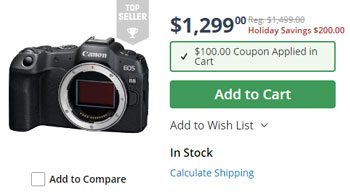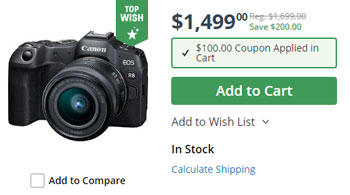Join More Than 50,000+ Subscribers and get latest camera news and rumors
NEW CAMERA VIDEOS ON YOUTUBE
|
By admin, on April 8th, 2025
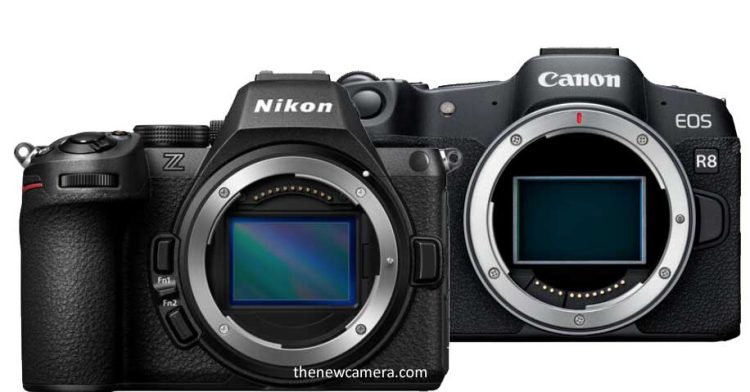
Let’s compare the Nikon Z5 II vs Canon R8, We have compared the two best entry-level cameras on this page; the first part of the comparison is dedicated to ” Best camera for still shooters,” and the 2nd part is the “best camera for Video shooters”. Now, let’s explore the content.
Table of Contents for Photography Part
🔎 Table of Contents: Video Capabilities Comparison
Best Camera for Photographers
Canon R8 is a lightweight full-frame camera weighing approximately 450 grams, whereas Nikon is a bit heavy in your hand with 700+ grams. But the Nikon build is more like a professional camera, not an entry-level design like we have in the Canon R8, and we have a single card slot in the Canon R8 camera. We have to add our batteries in the same card slot like we have to do in the entry-level cameras, but in the Nikon Z5 Mark 2 camera we have dedicated dual card slots and we have to insert our battery in the battery compartment. They are not mixed.
Handling and Ergonomics
Now both cameras are made by DSLR giants, great camera makers of all time, so the hand grip of both cameras and how the viewfinder is placed is very correctly done, so neither of the cameras will give you discomfort or hand pain while you are using them for a longer period of time.
Limited availability of Canon full-frame lenses in Canon RF Mount – The problem begins when you start looking for different variety of lenses as per your requirement and specific needs, then there is a huge possibility that some of the Canon lenses will ultimately go out of your budget and this may create a level of frustration that you have to deal with whenever you start searching for your favourite lenses. The big reason behind this is Canon’s RF mount restriction on their third-party lenses. And when I am creating this article, none of the third-party lens makers have started creating full-frame lenses for Canon RF Mount.
| Aspect |
Nikon Z5 Mark II |
Canon R8 |
| Battery |
1x EN-EL15c Rechargeable Lithium-Ion (Included)
✅ • Approx. 380 Shots |
1x LP-E17 Rechargeable (Included)
• Approx. 150 Shots |
| Lens Availability |
✅ Better third-party support expected (no such strict RF-like restriction mentioned). |
Limited variety; Canon RF mount restricts third-party full-frame lenses. |
| Third-Party Lens Support |
✅ Some third-party lenses are or will be available. |
None available at the time of writing for full-frame RF mount. |
| Camera Weight |
1.5 lb / 700 g (With Battery, Recording Media) |
✅ 1.0 lb / 461 g (With Battery, Recording Media) |
| Build Quality |
✅ Professional-style build. |
Entry-level design. |
| Card Slots |
✅ Dual dedicated card slots. |
❌ Single card slot. |
| Battery & Card Slot Design |
Separate battery compartment and dual card slots. |
Battery and card share the same slot, like entry-level cameras. |
| Ergonomics & Handling |
Good hand grip, no discomfort during long use. |
Good hand grip, no discomfort during long use. |
| Manufacturers |
Made by Nikon, a DSLR giant. |
Made by Canon, a DSLR giant. |
| Viewfinder Placement |
Well placed for comfortable use. |
Well placed for comfortable use. |
Photography Comparison
The Canon R8 camera uses a 24.5MP BSI CMOS Full-frame sensor, and the Nikon Z5 II camera uses a 24.2MP FSI CMOS Fullframe sensor. So, technically and even in samples we have seen and witnessed that the BSI CMOS sensor produces better low-light images with less noise, so if we compare both, we will see one stop of better low-light performance from Nikon Z5 II.
At the very same time, we also have some advantages associated with Canon’s sensor, Canon’s research and development team has done their task very beautifully, and despite being an FSI CMOS sensor, they have updated the bus structure inside the sensor, and the readout speed of the sensor has been upscaled to 14.5ms. Whereas the Nikon Z5 II readout speed is 22ms.
| Aspect |
Canon R8 |
Nikon Z5 II |
| Sensor Type |
24MP FSI CMOS |
24MP BSI CMOS |
| Low Light Performance |
Good, but slightly behind BSI |
✅ Better low light, ~1 to 2 stop advantage |
| Readout Speed |
✅ 14.5ms (faster) |
22ms (slower) |
| Sensor Optimization |
✅ Updated bus structure for faster readout |
Standard BSI architecture |
Image Quality Test
Nikon Z5 II camera uses a full frame BSI CMOS sensor and in the low light test you can see the camera is able to extract 1 to 2 stops better performance than the Canon R8 at 102400 ISO range.
And that’s not only limited to 1 or 2 stops of updated low light performance since the camera also features sensor shift-based stabilization mechanism which is effective up to 7.5 stops, so the camera also allows you to use shutter speed at least 4 to 5 stops slower without any issues.
Nikon uses the same advanced image stabilization system that we have seen in the Nikon Zf. You can link your autofocus points with the camera’s VR, that will help you to get a true 7.5 stops of IBIS.
So if we combine all these factors—BSI CMOS sensor and 7.5 stops of sensor shift image stabilization—then the Nikon Z5 Mark II camera becomes the best camera for low light or handheld photography.
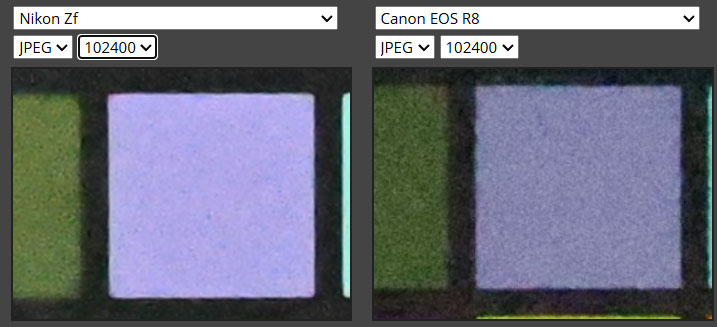
Now in the base ISO range, we can witness a very little bit of difference, but it’s still there—it exists. And the difference is the presence of optical low-pass filter inside Canon R8, and due to that, the details that we are getting, the words that we are reading, look a bit faded—only by a fraction—compared to Nikon, where we do not have any low-pass optical filter over the sensor and that’s why we are getting slightly better and clearer images.
Nikon camera not using a low-pass filter from the DSLR era, so if you want to do research, start researching entry-level DSLR models like ” Nikon D5600 without optical low filter,” and so on.
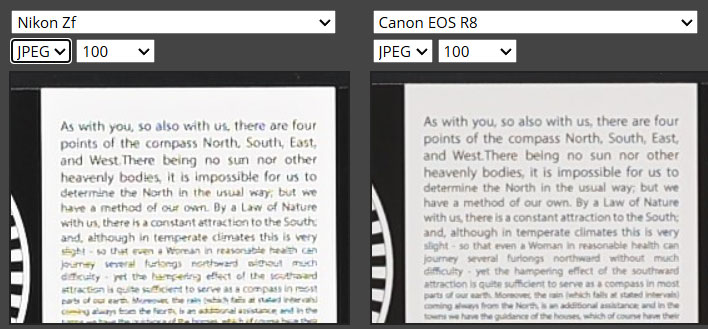
Image Stabilization
Nikon Z5 Mark II camera features 7.5 stops sensor-shift image stabilization system which helps to capture your creation with clear shots even in extreme low light environments. We also have electronic (with crop) image stabilization in video, so in video you get enhanced image stabilization support of mechanical as well as electronic.
In Canon R8, we do not have any sensor-shift image stabilization support. Yes, you can use OIS lenses which roughly work up to 4.5 stops to support your handheld shooting. In video mode, you do get EIS support with crop.
| Feature |
Nikon Z5 Mark II |
Canon EOS R8 |
| Sensor-Shift Stabilization |
✅ Yes, 7.5 stops sensor-shift IBIS.
Allows shutter speeds 4–5 stops lower. |
❌ No IBIS.
Supports up to 4.5 stops via OIS lenses. |
| Video Stabilization |
✅ Electronic IS (with crop) in video + IBIS for enhanced stabilization. |
✅ EIS available in video (with crop). No sensor stabilization. |
| High-Resolution Mode |
✅ Yes, 96MP Pixel Shift mode (Tripod required; processed via Nikon NX software). |
❌ Not available. |
| Autofocus System |
273-point Hybrid AF
Supported by EXPEED 7 and AI AF (same as Nikon Z8)
Detects 9 subjects |
✅ 4897 DPAF points (1053 cross-type)
DPAF II with superior tracking from R6 Mark II lineage |
| AF Tracking |
✅ Advanced AI-based subject detection: Humans, pets, bird eye AF, vehicles, etc. 9 Different types of subject detection. |
Fast tracking with Canon’s advanced DPAF II system.
Faster sensor readout improves response. |
| Burst Shooting (Mechanical) |
✅ Up to 11 fps RAW and 14 FPS Jpeg (mechanical shutter)
Clean results with no rolling shutter artifacts. |
❌ No full mechanical shutter
EFCS at 6 fps. |
| Burst Shooting (Electronic) |
Up to 30 fps Full res. (JPEG only) with electronic shutter. |
✅ Up to 40 fps (electronic shutter)
Great for sports/action. |
Autofocus
- Nikon Z5 II: Features a total number of 273-point hybrid AF system, but now the sensor is supported by EXPEED 7 image processor loaded with the same AI AF as we have seen in Nikon Z8. Due to the AI algorithm, the camera can track and predict the movement of 9 different types of subjects, which include human face and eye, pet’s face and eye as well as it also features a dedicated bird eye AF mode for wildlife shooters.
- Canon EOS R8: Canon R6 Mark II 24mp DPAF sensor and Number of focus points, 4897; Number of cross-type focus points, 1053. Canon is working on HYBRID AF sensors and DPAF sensor tech, from the DSLR era. Their camera does have superior autofocus tracking performance without a doubt.
So either you use any of them, none of them will disappoint you, but even if some asks me about the best Camera for AF. Due to the faster readout speed of the Canon R8 sensor, the overall response time becomes fast, and in a lab environment, text Canon will show up with better tracking performance.
Burst Shooting
- Nikon Z5 II: Features continuous shooting speed up to 11fps (mechanical shutter) and 30fps (electronic shutter, JPEG only). So, images are highly usable up to 11 FPS since,e as we all know, the mechanical shutter overrides the sensor readout speed, so if ur using the camera up to 11 FPS, free from rolling shutter effect.
- Canon EOS R8: Does not have a full mechanical shutter, it’s limited to EFCS and Electronic shutter, provides max 6fps (electronic first curtain) and an impressive 40fps (electronic shutter). The higher electronic burst rate makes it superior for action and sports photography.
Sensor Shift Image Stabilization
Nikon Z5 Mark II camera features 7.5 stops sensor-shift image stabilization system, You can use shutter speed Lower up to 4-5 Stops than as per the requirement of the situation, which helps to capture your creation with clear shots even in extremely low light environments. We also have electronic (with crop) image stabilization in video, so in video you get enhanced image stabilization support of mechanical as well as electronic.
In Canon R8, we do not have any sensor-shift image stabilization support. Yes, you can use OIS lenses which roughly work up to 4.5 stops to support your handheld shooting. In video mode, you do get EIS support with crop.
High Resolution Pixel Shift Mode: It’s a part of the Nikon IBIS system, and it allows you to capture 96 Mo of High-resolution images, But you have to use tripod for this mode, and the images are later processed by Nikon NX software.
Viewfinder and Screen
- Nikon Z5 II: 3000 NITS Brightness in EVF, the 3.69 Mdot resolution, the EVF now has brightness scaled up to 3000 Nits, which helps a photographer to easily capture a shot without any screen visibility issues, which generally happens in bright sunlight, and a 3.2-inch, 2.1 M-dot fully articulated touchscreen.
- Canon EOS R8: Limited to 2.36 M-dot EVF (0.7x magnification) and a 3.0-inch, 1.62 M-dot fully articulated touchscreen.
Verdict and Conclusion / Best Camera for Photographers
For Photographers
- Action/Sports Photographers: The Canon R8 tops with 40 FPS electronic shutter and faster sensor readout speed. Also, we have to note that the R8 lacks of full mechanical shutter, and with the help of EFCS shutter, the max continuous speed we will be getting is 6 FPS. Nikon Z5 II uses a full mechanical shutter and a MAX continuous shooting speed up to 11 FPS with mechanical (RAW)and up to 30 FPS with electronic, so if ur love to have the MAX speed possible and rolling shutter effect doesn’t bother you then you should go with Canon otherwise,e with Nikon up to 14 FPS
- Landscape/Low-Light Photographers: Nikon Z5 II camera features 7.5 Stops, IBIS, and better low-light performance due to the presence of a 24 MP BSI CMOS sensor.
- Wedding/Event Photographers: The Nikon Z5 II stands out with dual card slots for backup, longer battery life, and a robust build, ensuring reliability during long events.
- Travel Photographers: The Canon EOS R8 wins with its 461g weight and compact size, and uses the OIS lens, it’s good to go like 28-70mm F2.8 OIS, but in Z5 II its 700gm camera but features IBIS, so you can pair non-IBIS lenses with ease.
Video Features Comparison Table
| Feature |
Nikon Z5 II |
Canon EOS R8 |
| Video Resolution |
4K @ 60fps (1.5x crop), 4K @ 30fps (full width) |
✅ 4K @ 60fps (1.1x cropped, 6K oversampling) |
| Slow Motion (FHD) |
Up to 120fps |
✅Up to 180fps |
4:2:2 10 Bit internal Recording
|
Yes |
Yes |
| Log Support |
Yes (Clog3) |
Yes (NLog) |
| Image Stabilization (Video) |
✅7.5 stops IBIS + EIS |
Only EIS (no IBIS) |
| Autofocus System |
273-point Hybrid AF with AI (Z8-level subject tracking incl. bird-eye AF) |
Dual Pixel CMOS AF II, 4897 AF Points, fast tracking |
| Sensor Type |
24MP BSI CMOS |
24MP FSI CMOS |
| Dynamic Range |
✅Up to 15.5 stops |
Around 13.7 stops |
| Waveform Monitor |
Yes |
No |
| Preloaded LUTs |
✅Yes (4 RED LUTs) |
No |
| Audio Support |
✅24-bit 4-channel (analog), 16-bit (MP4) |
16-bit only |
| Battery Life (CIPA) |
✅~780 shots / ~2+ hrs 4K video |
~370 shots / ~1 hr 40 mins video |
| Connectivity |
HDMI Type-A, dual 3.5mm mic/headphone jacks |
HDMI Type-A, dual 3.5mm mic/headphone jacks |
| Low-Light Suitability |
Excellent (BSI + IBIS combo) |
Moderate (no IBIS, FSI sensor) |
| Best For (Use-Case) |
Handheld vloggers, wedding cinematographers, low-light shooters |
Gimbal users, slow-mo content creators, studio talking heads |
| Lens Ecosystem |
✅Wide open (Z-mount + third-party support) |
RF mount (limited budget-friendly third-party options) |
Video Frame Rates
Canon R8 offers an amazing advantage over the Nikon Z5 Mark II camera in terms of video frame rates. If you compare the two, Canon is able to record 4K UHD at 60fps using 6K oversampling without crop. Nikon Z5 II does record 4K 60fps video, but with 1.5x crop.
The Canon R8’s standout feature is its slow-motion capability at 180fps in Full HD, offering more creative options for dynamic content.
So if you need uncropped 4K 60fps video from your camera, then without a doubt Canon R8 should be the choice for you.
Sensor-Shift IBIS in Video
Nikon provides sensor-shift image stabilization in video, and when you pair the Nikon camera with VR lenses it becomes more effective. EIS (Electronic Image Stabilization) option is also available which adds more stability over the mechanical IBIS.
Canon R8 remains limited to electronic stabilization in video mode, and we don’t have any mechanical sensor-shift image stabilization system inside it.
So for handheld shooting, it’s highly recommended to have a camera like the Nikon Z5 II. While in the case of Canon R8, you have to get a proper gimbal with OIS lenses.
Codecs and Color Depth
Both cameras support up to 10-bit color depth in H.265 (HEVC) and H.264 (MPEG-4 AVC) formats. But as we all know, the dynamic range of Canon’s 24-megapixel FSI CMOS sensor is limited to 13.7 stops. So it will be producing a bit limited dynamic range when compared to the 15.5 stops of Nikon Z5 II’s 24-megapixel BSI CMOS sensor.
What does it mean to you? It clearly means that you have to work under proper lighting conditions to get the maximum output from the Canon R8 camera. Other than that, for low-light environments, the Z5 II sensor is more suitable since it’s also backed by IBIS, making it more convenient for handheld recording.
Now this section will be relevant for professionals only. If you are working in color grading and love to apply RED LUTs over your footage, then Nikon Z5 II does have 4 preloaded RED LUTs inside it.
Moreover, you also get a waveform monitor instead of just a histogram monitor like we generally get in Canon R8. The waveform monitor helps us to evenly expose the entire scene more properly and accurately than the histogram.
Audio and Connectivity
Both cameras feature dual 3.5 mm jacks — one for the microphone and the other for the headphone port for monitoring audio.
The interesting part is that the Nikon Z5 II camera now features 24-bit 4-channel audio support while recording in analog, and when you’re recording in MP4 format, you get 16-bit audio support from the camera.
In Canon R8, we only have 16-bit audio support.
Connectivity is similar, with HDMI Type-A (mini) outputs for external monitors or recorders, making both suitable for studio setups.
Battery Life and Special Features
The battery life of the Nikon is slightly longer since you are getting approximately 780 shots as per the CIPA standard. Specifically in video, we are getting 2+ hours of recording time at 4K 30fps.
In Canon R8, we have a smaller battery and compact body, so the overall recording time is approximately 1 hour and 40 minutes, due to the battery limitations.
Nikon Z5 II’s BSI CMOS sensor as well as 7.5 stops of sensor-shift image stabilization, are the two main factors that will allow you to capture crisp and clear shots in uncontrolled lighting environments.
Even if you are doing handheld shots, this camera will help you a lot more than the Canon — without a doubt.
So if you are a wedding cinematographer, think twice before investing. Not only is there no IBIS in the Canon camera, but the OIS lenses for Canon are also costly.
Suitability for Different User Types
- Content Creators: …Content creators who mostly use their camera on a gimbal and love to have a camera with higher frame rates like uncropped 4K 60fps or Full HD 180fps — especially for shooting dance videos or creating slow-motion reels — will find the Canon R8 more suitable.Pair it with a gimbal like DJI RS Mini 3 and high-quality Canon OIS prime lenses like 24mm, 35mm, and 85mm, and you’re good to go.
- Handheld Vloggers: …For handheld vloggers, we highly recommend going with the Nikon Z5 Mark II since this is the only camera that gives you mechanical image stabilization up to 7.5 stops.You will also get EIS support, which helps get clear handheld shots. This camera also features a BSI sensor that records clean video in low light.So, for handheld shooters, Nikon Z5 II is highly recommended — even if you don’t like the look of the camera, the output will speak for itself.
- Talking Head Video Creators: …Both cameras are excellent for talking-head videos since sensor-shift image stabilization is not needed in such scenarios.At the same time, when you are recording in a room, office, or studio setup with controlled lighting, the sensor type becomes less critical. All you need is a good Canon prime lens, and you’re good to go.So, if you wish to get the Canon R8, go ahead. Otherwise, the Nikon Z5 II is still an all-rounder.
- Wedding Cinematographers: ..The best camera for wedding cinematographers is the Nikon Z5 II since it offers sensor-shift image stabilization and a BSI CMOS sensor for better low-light performance.This will help ensure camera stability even when your gimbal fails or you run out of batteries. In such emergency scenarios, you can even shoot handheld.
- Reels Makers: …If you create reels and mostly use your camera on a tripod, then the Canon R8 is more recommended since it can record uncropped 4K 60fps video and Full HD video at 180fps.Technically, the R8 is faster and hence more usable for creating slow-motion sequences.But if you shoot your content handheld, then it’s highly recommended to go with the Nikon Z5 II.
Conclusion
Both cameras are excellent at their price points.
But the Nikon Z5 II has a wider approach due to the presence of a BSI CMOS sensor, sensor-shift image stabilization (IBIS) up to 7.5 stops — which can be linked with autofocus points — and, above that, we get a completely open lens mount to choose from a wide range of lenses at various price points.
The Canon R8 offers uncropped 4K 60fps video and Full HD 180fps slow motion, which is a unique offering. But it has limited dynamic range, lower low-light performance due to the FSI sensor, and the absence of sensor-shift stabilization.
So, its features — along with its limitations — make the Canon R8 ideal for a specific type of audience, but not for everyone.
Nikon Z5 II vs Nikon Z6 II | Nikon Z5 II vs Canon R8 | Nikon Z5 II vs Nikon Zf | Nikon Z5 II vs Sony A7 III
Get the Nikon Z5 II camera from B&H Store | Adorama.com | Amazon.com
Support us – Use or affiliate link Amazon.com | B&H Store | Adorama.com for the next purchase u make – it helps us 🙂
Follow us on our social pages FACEBOOK | TWITTER | INSTAGRAM to get live Camera News + Nikon Rumors 24X7
By admin, on February 3rd, 2025
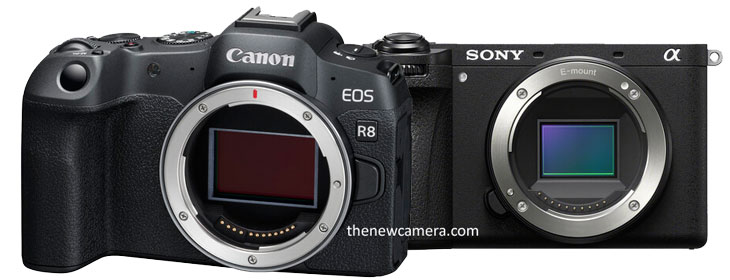
Discuss the best camera based on the specification comparison we have.
Let’s begin with the Canon R8. The R8 is a full-frame camera, and the major advantages we have with this camera are superior low-light performance as well as better dynamic range. Since we have a full-frame sensor, the background blur or the depth in the images will be greater when using the same aperture-based lenses.
In the Sony A6700 camera, the major advantage we have is a compact, ultralight body with a huge range of E-mount lenses, as well as Sony’s advanced AI autofocus and sensor-shift stabilization system.
Now, both of these cameras are excellent choices for any beginner or semi-professional photographer, but at the same time, it’s very important to know your requirements and budget before purchasing a camera. Since you also need to invest a good amount of money in lenses, choosing the right camera for your needs is essential.
Get Canon R8 from – Amazon.com | Adorama | B&H Store |
Get Sony A6700 from – Amazon.com | Adorama | B&H Store |
Portrait & Wedding Photography
For portrait and wedding photography, where skin tones, background blur, and low-light performance are crucial, a camera’s ability to perform well in dim environments is highly important.
For portrait and wedding photography, we highly recommend the Canon R8. The full-frame sensor produces excellent background blur, and at the same time, Canon sensors are known for producing high-quality skin tones. So, if you are into wedding or portrait photography, where you frequently work with skin tones, it is highly recommended to use a Canon camera.
Additionally, the Canon R8 has superior low-light performance. Despite not having an FSI sensor, this particular camera’s low-light performance is phenomenal, as the sensor comes directly from the Canon EOS R6 Mark II. Overall, this particular camera offers a professional-grade body at a reasonable price.
The Sony A6700, on the other hand, has an APS-C sensor, resulting in a smaller depth of field and less background blur compared to a full-frame sensor. That’s why we do not directly recommend it over the Canon R8 when working on portrait sessions or weddings.
Lens Recommendations for Portrait & Wedding Photography
One important thing to note is that the Canon R8 does not have sensor-shift image stabilization, so it becomes highly essential to use optically stabilized lenses.
- For weddings and events, we recommend the Canon RF 28-70mm f/2.8 IS STM.
- For portrait photography, the Canon RF 85mm f/1.8 STM is a great choice.
Landscape & Travel Photography
For landscape and travel photography, where dynamic range, portability, and battery life matter the most:
When it comes to travel or landscape photography, most of the shooting will be done handheld. Specifically, when traveling or capturing landscapes, you need sensor-shift image stabilization (IBIS) inside your camera body to ensure sharp images.
Verdict: Sony A6700 is More Recommended for Landscape and Travel Photography.
Wildlife & Sports Photography
For wildlife and sports photography, where autofocus speed, continuous shooting, and telephoto reach are crucial:
If we compare the continuous shooting speed of both cameras:
- Canon R8 is capable of capturing 40 frames per second in JPG mode and up to 30 frames per second in RAW mode, which is far superior to the Sony A6700, which is limited to 11 frames per second.
- For action photography, capturing fast-moving subjects like birds or animals, the Canon R8 has a clear advantage in burst shooting speed.
Another associated advantage of a full-frame sensor is its low-light performance and dynamic range. When you are shooting wildlife or animals, they are often found in uncontrolled lighting conditions. Having a full-frame sensor allows you to extract more details and recover highlights in post-processing.
However, despite all these advantages of the Canon R8, for sports and wildlife photography, we highly recommend the Sony A6700, and here’s why:
Why the Sony A6700 is Recommended for Wildlife & Sports
- Sensor-Shift Image Stabilization (IBIS)
- The Sony A6700 has IBIS, which is a huge advantage for wildlife and sports photographers.
- If you are using lenses like the Sony 200-600mm f/5.6-6.3 G OSS, the sensor-shift IBIS will pair with the lens’s optical stabilization, allowing for stable handheld shots of moving subjects.
- While a tripod or monopod is always recommended, IBIS helps tremendously in handheld shooting.
- APS-C Crop Factor for Extra Telephoto Reach
- The 1.5x crop factor of the APS-C sensor gives more reach with telephoto lenses.
- Even with a 200-600mm lens, the effective focal length increases, providing exceptional close-up shots of birds and animals.
- With a full-frame sensor, you are limited to native telephoto lenses, which are significantly more expensive.
- If you use a full-frame camera in crop mode, the resolution drops significantly (Canon R8 in APS-C mode drops to ~10MP). In contrast, the Sony A6700 maintains its full 26MP resolution.
Final Verdict
Based on the specifications:
- For Portrait & Wedding Photography → Canon R8 (Full-frame, superior skin tones, better background blur, low-light performance)
- For Landscape & Travel Photography → Sony A6700 (IBIS, compact, battery life, dynamic range for landscapes)
- For Wildlife & Sports Photography → Sony A6700 (IBIS, AI autofocus, crop factor for better telephoto reach, affordable telephoto lenses)
Would you like further lens recommendations or a budget breakdown for your needs?
Table 1: Differences Between Sony A6700 and Canon R8
| Feature |
Sony A6700 |
Canon R8 |
| Lens Mount |
Sony E-mount |
Canon RF-mount |
| Sensor Size |
APS-C (23.3 x 15.5 mm) |
Full-Frame (35.9 x 23.9 mm) |
| Resolution |
26 MP |
24.2 MP |
| Image Stabilization |
5-Axis Sensor-Shift |
Digital (Video Only) |
| ISO Range |
100–32,000 (Ext. 50–102,400) |
100–102,400 (Ext. 50–204,800) |
| Continuous Shooting |
11 fps (59 RAW / 1000 JPEG) |
40 fps (56 RAW / 120 JPEG) |
| Autofocus Points |
759 (Photo) / 495 (Video) |
4897 (Photo) / 4067 (Video) |
| AF Sensitivity |
-3 to +20 EV |
-6.5 to +21 EV |
| Video Modes |
UHD 4K 120p / FHD 240p / 10-Bit 4:2:2 |
UHD 4K 60p / FHD 180p / 10-Bit 4:2:2 |
| External Video |
4K 60p 4:2:2 10-Bit via HDMI |
1080p 60p via HDMI |
| Gamma/Log Profiles |
S-Log3, HLG, S-Cinetone |
Canon Log 3, HDR-PQ |
| Recording Limit |
Unlimited |
120 Minutes (4K/1080p HFR) |
| Viewfinder Magnification |
1.07x |
0.70x |
| Battery Life |
550 Shots (NP-FZ100) |
150 Shots (LP-E17) |
| Weight |
493g (1.1 lb) |
461g (1.0 lb) |
| Display Resolution |
1.03M Dots |
1.62M Dots |
| Wireless |
Wi-Fi 5 (802.11ac) |
Wi-Fi 4 (802.11n) |
| Exposure Compensation |
-5 to +5 EV |
-3 to +3 EV |
| Shutter Speed (Electronic) |
1/8000s |
1/16000s |
| Price |
~$1,398 (Body) |
~$1,299 (Body) |
Table 2: Similarities Between Sony A6700 and Canon R8
| Feature |
Sony A6700 |
Canon R8 |
| Capture Type |
Stills & Video |
Stills & Video |
| Shutter Type |
Mechanical & Electronic Rolling Shutter |
Mechanical & Electronic Rolling Shutter |
| Bulb/Time Mode |
Bulb Mode |
Bulb Mode |
| Metering Method |
Center-Weighted, Multi-Zone, Spot |
Center-Weighted, Evaluative, Partial, Spot |
| White Balance |
2500–9900K, Multiple Presets |
2500–10,000K, Multiple Presets |
| Interval Recording |
Yes |
Yes |
| Self-Timer |
2/5/10-Second Delay |
2/10-Second Delay |
| Aspect Ratio |
1:1, 3:2, 4:3, 16:9 |
1:1, 3:2, 4:3, 16:9 |
| Image File Format |
HEIF, JPEG, Raw |
C-RAW, HEIF, JPEG, Raw |
| Bit Depth |
14-Bit |
14-Bit |
| Fast/Slow Motion |
Yes |
Yes |
| Built-In Microphone |
Stereo |
Stereo |
| Media Slot |
Single SD/SDHC/SDXC (UHS-II) |
Single SD/SDHC/SDXC (UHS-II) |
| Video I/O |
1x Micro-HDMI Output |
1x Micro-HDMI Output |
| Audio I/O |
1x 3.5mm Mic Input, 1x 3.5mm Headphone Output |
1x 3.5mm Mic Input, 1x 3.5mm Headphone Output |
| Power I/O |
1x USB-C Input |
1x USB-C Input/Output |
| Mobile App |
Sony Creators’ App (Remote Control, File Access) |
Canon Camera Connect (Remote Control, Settings, Live Feed, Firmware Update) |
| GPS |
Via Connected Smartphone |
Via Connected Smartphone |
| Display Size |
3.0″ Articulating Touchscreen LCD |
3.0″ Articulating Touchscreen LCD |
| Viewfinder Type |
0.39″ OLED, 100% Coverage |
0.39″ OLED, 100% Coverage |
| Diopter Adjustment |
-4 to +3 |
-4 to +1 |
| Built-In Flash |
No |
No |
| Flash Compensation |
-3 to +3 EV |
-3 to +3 EV |
| Tripod Mount |
1/4″-20 Female |
1/4″-20 Female |
| Operating Temperature |
0 to 40°C (32 to 104°F) |
0 to 40°C (32 to 104°F) |
By admin, on November 21st, 2023
Check out the latest ongoing deal on the Canon R8 camera. Right now, you can get a discount of approximately $300 on the Canon R8 camera. Here’s how you can avail the discount:
- You will get a direct discount of $200 when you add this camera to your cart.
- Once you proceed to checkout, a coupon worth $100 will be given to you. You can use this money to buy additional items like lights, camera filters, or whatever you like.
What to do with $100 Coupon ? Get VideoPRO Light @ 89 ONLY
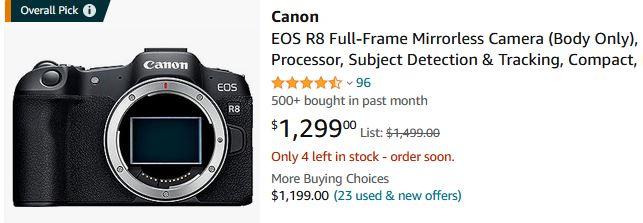
The Canon R8 is also available on Amazon.com with a $200 discount on the price. Unlike B&H store, we are not receiving a $100 coupon from Amazon. So, while we don’t have the additional coupon, we are still getting a $200 discount from Amazon overall.
Get Video Lights Under $100
By admin, on June 10th, 2023
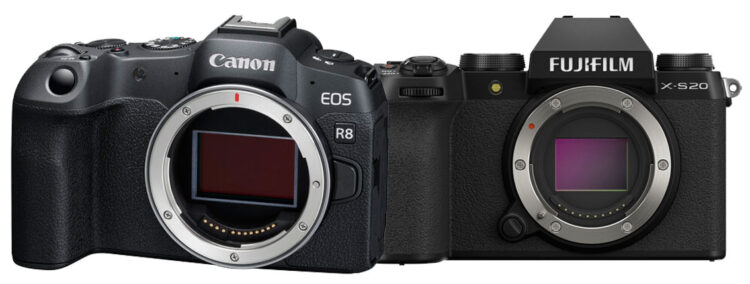
1. Sensor resolution and sensor size
The Canon R8 camera features the same sensor that we have seen in the R6 Mark II, the full-frame 24-megapixel Dual Pixel CMOS autofocus sensor of the 2nd generation. Inside the Fuji X-S20 camera, we have an APS-C sensor of 26 megapixels.
As usual, the larger pixels tend to capture more light than the smaller ones. We have a Fuji APS-C sensor with a denser megapixel network, and in Canon’s full-frame sensor, we have only 24 megapixels. But at the same time, we also have to consider that there is a technological difference. Fuji is using a BSI sensor and Canon is using an FSI CMOS sensor.
Fuji X-S20 vs Canon R10 – The 10 Main Differences
| Model Name |
Canon R8 |
FUJIFILM X-S20 |
| Sensor Resolution |
Effective: 24.2 Megapixel |
Effective: 26.1 Megapixel |
| Image Sensor |
35.9 x 23.9 mm (Full-Frame) CMOS |
23.5 x 15.6 mm (APS-C) CMOS |
| Image Stabilization |
None |
Sensor-Shift, 5-Axis |
| Built-In ND Filter |
None |
None |
| Capture Type |
Stills & Video |
Stills & Video |
This technology difference may make an impact on image quality, but image quality can also be affected by the laws of physics.
36.00µm2 vs 14.12µm2 approx 154% larger pixel area
So the big question is whether the 26-megapixel sensor will perform better in low light due to the BSI sensor technology or if a full-frame sensor with a 24-megapixel resolution will perform better. Let’s find out in the test.
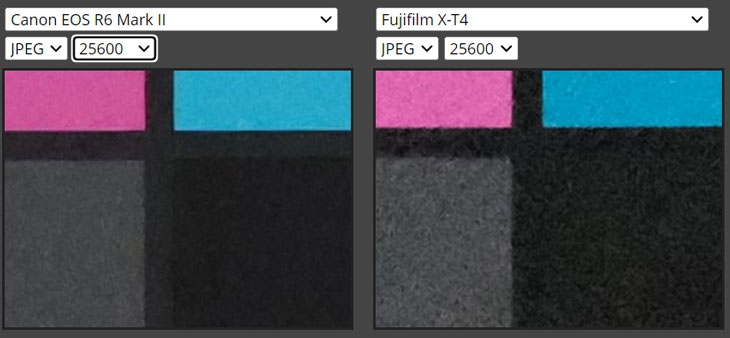
At ISO 25600, it is very clear that Canon R8 photos are preserving more detail compared to the Fuji X-S20. As you can see in the image, the color blocks are very well maintained and the details are preserved.
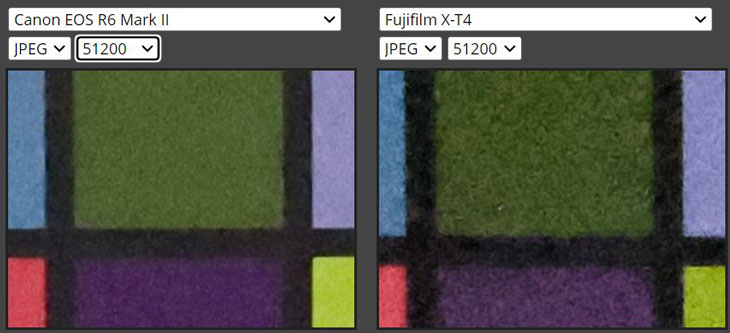
At ISO 51200, the Fuji X-S20 camera again fails to impress, with Canon R8 preserving more details even at higher ISOs compared to Fuji’s X-S20.
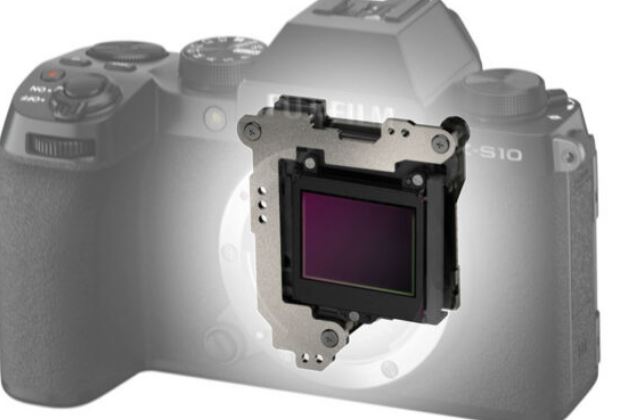
2. Sensor shift image stabilization
Fuji xs20 camera features a sensor-shift image stabilization system which is completely absent in Canon R8. One of the biggest advantages we have is the ability to use slower shutter speeds in low-light environments, resulting in better light efficiency, more light to the sensor, and hence cleaner images.
So in practical situations, if one knows how to use the image stabilization system properly in combination with the shutter speed of the camera, they may have better output than a full-frame camera without an image stabilization system.
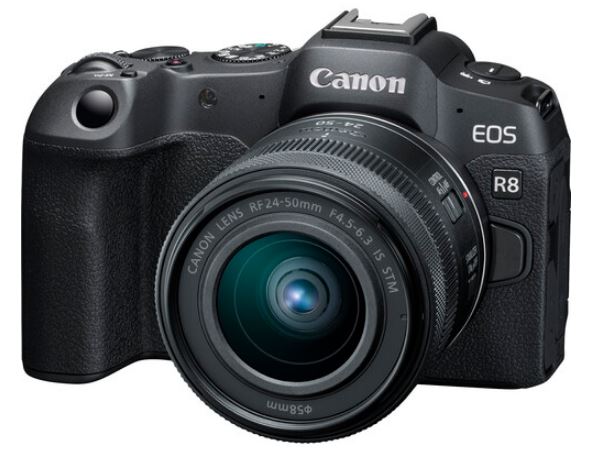
3. AUTO FOCUSING SYSTEM
| Canon R8 |
Fuji X-S20 |
|
Canon R8 AF Points on Sensor: 4897
Number of cross-type focus points: 1053 ( AF frame zones)
Class Leading AI AF technology coming straight out from Canon R3 AF system
MAX Brust speed 40 FPS @ full Res. AI/AF support (JPEG only)
MAX Brust speed 30 FPS @ full Res. AI/AF support (JPEG + cRAW) |
Fuji X-20 AF points: 425 HYBRID
Uses the Same AI AF as of Fuji X-H2s Camera
Now in auto mode, the camera can detect and track drones and insects too.
MAX 30 FPS with 1.5x CROP AI/AF support
MAX 20 FPS @ Full Res. AI/AF support (RAW + JPEG) |
From this specification analysis, it is obvious that the Canon R8 camera features an advanced autofocus system. For sports shooters or wildlife photographers, it is recommended to get the Canon R8 camera with lenses like 100-400 (Budget zoom). But if you are a daily life photographer, event shooter, wedding photographer, street shooter, portrait or fashion photographer, you will actually feel no issue while working with the autofocus system of the Fuji X-S20.
So for sports and wildlife photography, it is more recommended to get the Canon R8 camera, and for others, you can buy either of these two cameras.
4. Weather sealing in Canon
The Canon R8 camera is a weather-sealed camera, so it allows you to work in adverse situations where you may feel a bit worried about taking out your camera from your bag. But at the same time, the Fuji X-S20 is not weather-sealed, so you have to keep this in mind before buying either of these two cameras.
5. Double battery life of Fuji X-S20
With the Fuji X-S20 camera, you are getting approximately 750 shots per charge since, for the first time, they have used a professional-level battery in a mid-range APS-C series camera. However, you have to feel some limitations because the battery life of the Canon R8 camera is limited to 290 shots in a single charge. For those who mostly shoot outdoors, such as travel photographers, they must keep an extra battery pack for Canon cameras. The good thing is that both cameras allow you to charge via USB even when you are shooting
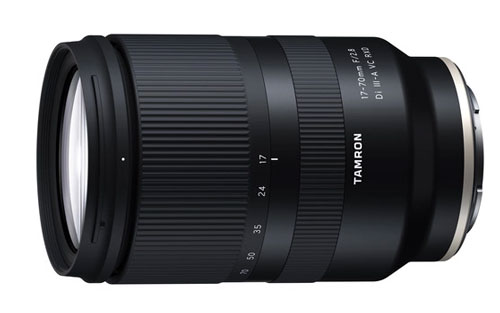
Get Tamron 17-70mm RXD Lens form Fuji X-S20 Camera – AMAZON.com | B&H Store
6. Open lens mount support:
The Fuji X-S20 camera has open lens mount support that Canon R8 doesn’t have. As a result, the availability of lenses in Fuji X mount is huge and at the same time, they are affordable when compared with Canon full-frame lenses that you have to buy with the Canon R8 camera.
So if you are interested in the Canon R8 camera, you have to keep an extra budget for collecting all the essential lenses for your camera. Otherwise, while working with variable aperture kit zoom lenses, you will never achieve the optimum image quality of the camera
So which camera you should buy as a photographer?
Yes, you can buy the Canon R8 camera in 2023, but you have to keep a few things in mind.
- The camera does have a full-frame sensor, resulting in better low light performance. But at the same time, you have to mostly buy OIS lenses to have proper output since the camera body doesn’t have any sensor stabilization system.
- The biggest issue that I see is the locked lens mount of Canon, so we have limited options at a higher price range. For lenses, you have to keep your budget at a different level so you can buy the set of lenses you actually require for your work.
- And the biggest advantage that you will have in your hands after having the Canon R8 camera is a class-leading autofocus system directly coming from the Canon R3 flagship model. This not only helps for still shooting but also incredibly helps for capturing videos.
Should you buy the Canon R8 camera in 2023?
So if you would like to buy the Canon R8 camera, there are only two things that affect me before directly recommending it to you. The first thing is the locked lens mount and the other thing for a photographer is the lack of an IBIS mechanism. For this, you have to keep a bigger budget and for the lack of an IBIS mechanism, you have to follow some rules like the shutter speed rule that you should keep while using different focal length-based lenses. So you will manage to get some sharp output from this camera. Otherwise, it’s an excellent camera at this price range.
So we have already discussed the still part of both the camera now discuss the video part
7. Best Cameras for capturing videos – Canon R8 vs Fuji X-S20
The Fuji X-S20 camera offers 6K video recording in an open gate format. Now we all know that nowadays 3:2 format videos are not that usable. With the Fuji X-S20 camera, you are also able to record 5.2K videos in the 16:9 standard format. Fuji is the only camera that offers 5.2K video recording in this price range with full-time autofocus support from third-party lens makers.
So these two advantages are completely absent in the Canon R8 camera.
Now let’s talk about the common strength of both cameras in video mode. The Canon R8, as well as the Fuji X-S20, both allow you to record 4K videos up to 60 frames per second uncropped. You can record 4K 60 FPS video in 4:2:2, 10-bit format inside your camera. Both cameras offer you the use of their C-Log and F-Log modes to extract the maximum out from the video mode.
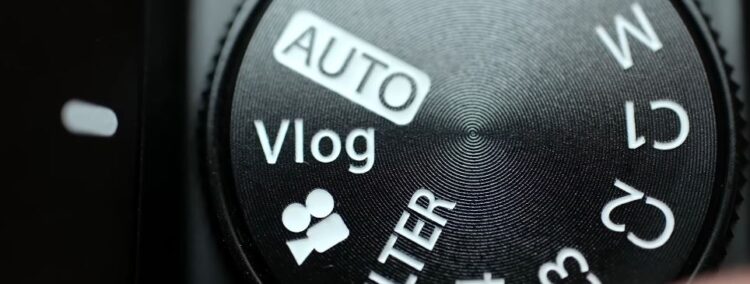
8. Dedicated VLOG Mode
Now let’s talk about a dedicated Vlog mode and more dial present on top of the camera. Fuji engineers worked hard to impress the new generation of content creators and for those, they have not only placed a dedicated Vlog menu on top of the camera but they have also designed a brand new user interface for content creators or those who are coming straight out from a smartphone.

In the new content creator menu, you will easily find the product showcase mode, face tracking priority mode and in different blocks of the content creator menu, it’s very easy to operate the camera and to switch to different modes which are not present right now in the Canon R8 camera.
9. IBIS for video and content creation
Finally, in video mode, we are also having the support of a mechanical image stabilization system in Fuji so that would be a great help when you are working and creating content or shooting cinematography with your camera. The IBIS mechanism will help you a lot in capturing stable footage from your camera.
Again, an open lens mount is one of the biggest factors to recommend Fuji over Canon right now. You have a huge range of lenses to select from which includes wide-angle lenses.
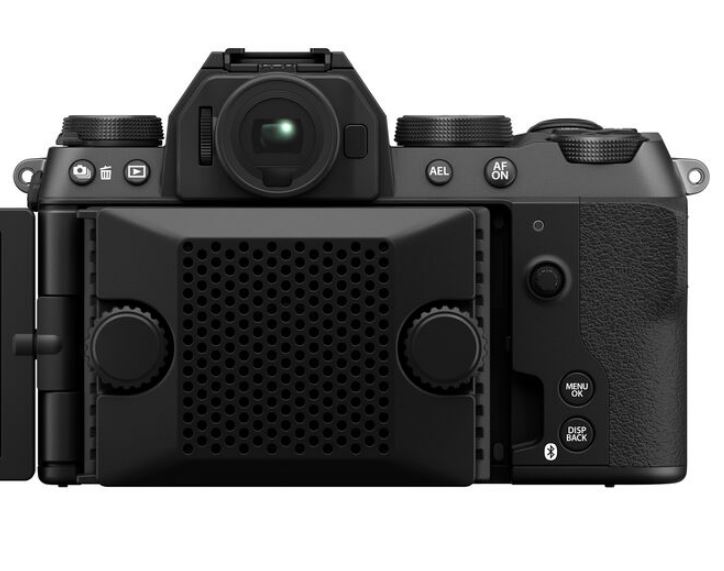
10. External fan
With the Fuji X-S20 camera, you get an option to add an external fan. So in case it overheats when you are shooting in the summer months of June and July, the external fan will double the shooting time length of your camera whether you are shooting in 4K or 5.2K. No such extension is available in the Canon R8 camera although we didn’t receive any major overheating issues related to it.
Let’s talk about which camera is best for videographers, cinematographers, and content creators.
Best Camera For videographers and cinematographers,
Both cameras are highly usable. Specifically, if you are working in an uncontrolled light environment, then you might have the advantage of the Canon full-frame sensor. The camera is capable of recording 4K 60fps videos and due to the large pixels, you will have slightly better low-light performance when compared to the APS-C crop sensor of the Fuji camera.
However, there are two disadvantages.
- One is the absence of an image stabilization mechanism that restricts its handheld use while shooting videos.
- The second disadvantage for videographers is the absence of a proper lens range in your budget.
Why you should prefer the Fuji X-S20 over the Canon R8 for videography and cinematography?
- The big reason to buy the Fuji X-S20 camera is its ability to record 5.2K videos at 16:9 format at a rate of 30 frames per second.
- Despite having an APS-C CMOS sensor, the overall bitrate is 360 Mbps which is a bit more than Canon R8’s 340 Mbps. This directly means you are getting more color information resulting in enhanced video quality. The only disadvantage that we have discussed is that you may face some low light disadvantages due to the limited APS-C sensor size. But if you are shooting in low light, it’s recommended to use Fuji’s F-Log2 (claim to have 13 stops of DR) to extract the maximum quality possible from a given scene.
- The biggest known advantage while using the X-S20 camera is the availability of a huge range of lenses from third-party lens makers.
- presence of an image stabilization system that helps you get stable footage on the move and at the same time,
- the ability to add an external fan to double the recording time.
Best camera for content creators at this price range:
The Fuji X-S20 camera is the best camera we know for content creators at this specific price. Now, Fuji’s autofocus system is much improved and it features multiple autofocus modes for content creators. At the same time, we have a dedicated content creator menu that you can operate efficiently, and as usual, there is a range of lenses for you. More or less, the X-S20 has now become the best and most highly recommended camera for content creators.
Get Canon R8 Camera from Amazon and B&H Store
Fuji Film X-S20 – Camera $1299 [Body Only B&H] [Amazon.com] | 15-45mm Lens $1399 [B&H Store] [Amazon.com]
By admin, on March 25th, 2023

DXOMark is really surprised to test out the new Canon R8 camera. The overall test of the Canon R8 camera looks similar to a 24 Full-frame BSI CMOS Sensor. Take a look what DXO Mark Said
Although neither ‘back-side-illuminated’ nor ‘stacked’ the 24.2 MP CMOS sensor in the Canon EOS R8 has similar performance characteristics to BSI sensors from rivals. As a result, it makes sense to compare it with the 24.2 MP BSI CMOS in the Nikon Z6 II even if that camera sits at a higher position in the market.
It’s really appreciable that the Canon R8 camera sensor FSI Sensor is performing so well in the lab test, now able to compete against BSI Sensors of the same range. Just imagine when will happen when Canon will bring out its BSI variant of their FSI Sensors. It will surely blow away the existing competition.
DXO Mark about Canon R8
- The EOS R8’s 24.2MP sensor achieves a DXOMARK score of 93 in our tests.
- It was ranked 10th overall and 3rd for Canon sensors.
- It greatly exceeds the 85 points of the EOS RP and is better than the 1D X Mark III.
- It is slightly lower than EOS R5/R3.
- Dynamic range is what I’m most good at. Nearly 15 stops (14.7EV) at base sensitivity (ISO100). It is a peak value similar to the high-end EOS R5 and R3.
- It also has good color depth and a low light score between the R5 and R3 cameras.
CanonEOS R8 vs Others
|
Comprehensive |
color depth |
DR |
Low light ISO |
| Canon EOS R8 |
93 |
24.5 |
14.7 |
3295 |
| EOS R3 |
96 |
25.0 |
14.7 |
4086 |
| Canon EOS R5 |
95 |
25.3 |
14.6 |
3042 |
| EOS R6 |
90 |
24.2 |
14.3 |
3394 |
| EOS R |
89 |
24.5 |
13.5 |
2742 |
| EOS RP |
85 |
24.3 |
11.9 |
2978 |
| α7IV |
97 |
25.4 |
14.7 |
3379 |
| Z6II |
94 |
25.0 |
14.4 |
3303 |
| α7III |
96 |
25.0 |
14.7 |
3730 |
Get LIVE RUMORS –> FACEBOOK | TWITTER | INSTAGRAM to get live news + Canon rumors 24X7
source DXOmarkLab
By admin, on February 27th, 2023
Finally, we have the PDR Fuji X-T5, thanks to Photons to Photos for uploading the test results so fast. So, now we have a Fuji Camera Under $2000 which features a 40MP X-Trans sensor.
Now, let’s talk about what is PDR for beginners, Photographic Dynamic Range is a measure of a camera’s sensor’s ability to capture and reproduce (in short resolve) the full range of tones in a scene, from the brightest highlights to the darkest shadows.
So, I think the PDR chart is a valuable tool for photographers seeking to compare the dynamic range of different cameras and can assist in determining which camera is best suited for their specific needs.
Specifically when ur shooting in an uncontrolled light environment, Like a Landscape, architecture, or even a portrait in uncontrolled light, if the camera has a better PDR range you can recover details from shadows in a better way.
If you are confused between the Canon R8 and Fuji X-T5 image quality, this post will clear 50% of your confusion. Since being a Fullframe camera Canon R8 is more affordable and features a full-frame sensor (although IBIS is missing), but this post we are limited to Dynamic Range TEST only.
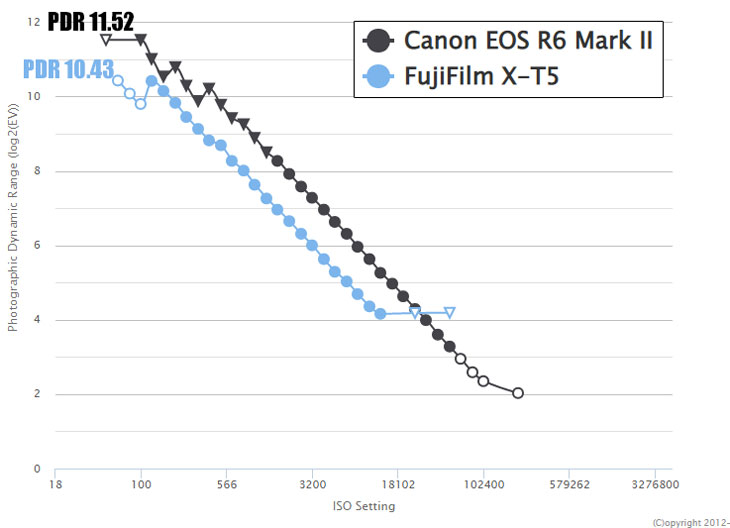
1. Canon Beat Fuji in Dynamic Range Test – (Under $2000 Camera Range)
I am comparing here the Canon R8 camera Sensor PDR with the Fuji X-T5 (We will use the Canon R6 Mark II PDR range since the Image sensor and image processor of both the camera exactly the same), yes we do have many other aspects of comparison and in those, we may see Canon R8 fail miserably. But, when we are comparing the test results of the Canon R8 aka R6 mark II camera sensor with the Fuji X-T5 we are surprised that how well a Canon FSI technology based 24.2 MP Sensor is performing in comparison to Fuji’s latest 40MP X-Trans BSI CMOS APS-C. Although we do have a massive resolution difference between the two as well as a size difference.
Canon 24.2 MP Fullframe sensor features an 11.52 PDR range vs Fuji 40Mp Sensor remains limited to 10.43 PDR. So, its a very clear that if you need better dynamic range Canon R8 is better
2. High ISO Test (Canon 24MP vs Fujis 40 MP)
We have conducted a High ISO test between, Canon R6 Mark II and Fuji X-H2 Camera. Since as you know the Canon R8 uses R6 Mark II and the Fuji X-H2 camera uses a Fujis X-H2 40MP X-Trans BSI CMOS sensor, let’s us see which one preserves more details.
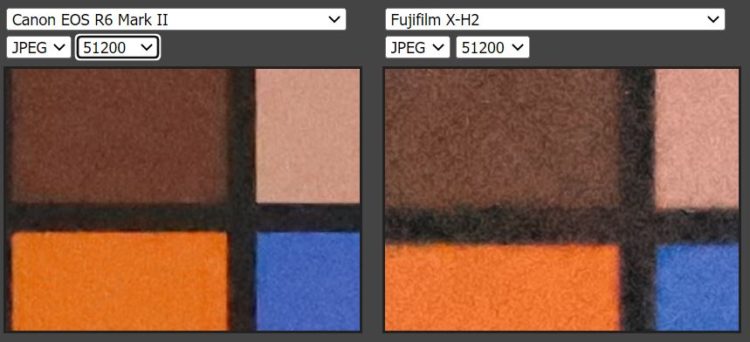 AT ISO 512000 its clearly visible that the Canon R6 Mark II sensor preserves more details compared to Fujis source dpreview.com/reviews/image-comparison From both PDR (Dynamic range test) as well as HIGH ISO test, it’s very clear that the Canon 24MP Full frame sensor is performing well compared to the Fujis 40MP sensor.
Finally, let’s compare the base ISO, and the details capturing ability of both cameras. And in this test, we are sure that Canon will fail miserably.
3. Base ISO Test
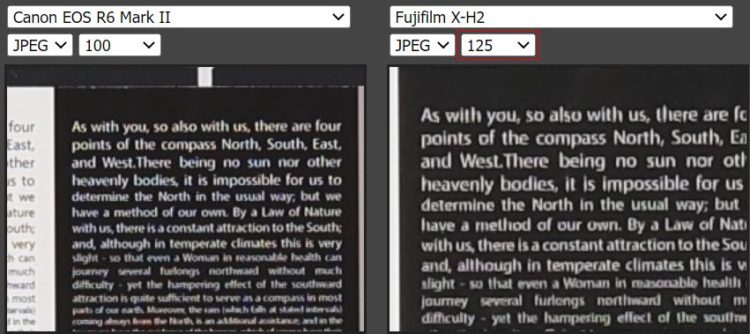
As you can clearly see the details capturing ability of the Fuji’s 40MP, so if you are working in a controlled light environment then the best sensor to work with is Fujix 40 X-Trans sensor presented in the Fujix X-H2 and the Fuji X-T5 Camera.
|
Canon R8 |
Fuji X-T5 |
| PDR TEST |
11.52 |
10.43 |
| Low-Light |
1+ Stop Advantage |
|
| Base ISO |
|
16 MP + (More Details at Base ISO) |
|
|
|
Get Canon R8 camera from Amazon | B&H Store
Get Fuji X-T5 Camera from Amazon | B&H Store
SHARE YOUR THOUGHTS WITH US
If the decision to remove the mechanical shutter from Canon R50 is correct?
Get LIVE RUMORS –> FACEBOOK | TWITTER | INSTAGRAM to get live news + Canon rumors 24X7
By admin, on February 8th, 2023

Canon R8 camera announced the camera features a 24MP full frame DPAF sensor, the same sensor we have seen in the Canon R6 Mark II camera. The Image processor is also the same, but the only thing that isn’t the same is the absence of IBIS. The Canon R8 features 4897 AF Points and 1053 AF Zones in the sensor. So, you get approx 100% coverage from your camera. According to Canon, the Canon R8 camera is loaded with more machine learning in its AF algorithms and inherits some of the technology from its flagship EOS R3 (but not the R3’s eye-controlled AF system). This should result in in super fast Autofocus Tracking performance.
Same as of the Canon R6 II, the Canon R8 also features enhanced tracking modes that are not only limited to ‘people’ and ‘animals, now you can also track a vehicle, cars, motorcycles, aircraft (including helicopters), and trains. Animal tracking also supports horses and zebras. So, the AF system of the camera is the best in its class. It’s capable of burst rates up to 40fps with the electronic shutter, though the camera drops to 12-bit readout to achieve this. Now, let’s have a look at the video core specification
The Canon R8 camera is capable to record UHD 4K/60p video via full sensor readout– no crop. It’s also possible to capture 4K/60p from an APS-C crop of the sensor. According to Canon, the Canon R8 uses almost the same heat sink mechanism as the Canon R6 mark II camera, you can record 4k 60fps videos up to 40 minutes without any issue. There are no time restrictions when shooting at slower frame rates like 4K/30p or 4K/24p. At Full HD video mode you can shoot up to 180 FPS.
Canon R8 Major Specification
-Effective 24.2-megapixel Fullframe CMOS sensor (with low-pass filter)-No
sensor self-cleaning function-
DIGIC X
-EVF 0.39 inches, 2.36 million dots organic EL, 100% field of view, magnification 0.96 Double, eye point 22mm
– AF is dual pixel CMOS AF, still supports EV -4.0 to 20
– 651 AF points (auto) for still, 57 points for video
– Still AF points (manual) is 4503 points, movie is 3713 points
– AF supports EV – 4.0 to 20 for stills, EV – 3.5 to 20 for movies
– 384-segment metering, metering range from EV -2 to 20 for stills, EV 0 for movies From 20
– Subject recognition, people, animals (dogs, cats, birds), vehicles (motor sports cars, motorcycles), eye recognition
– ISO range 100-32000 (ISO 51200 with extension)
– Electronic front curtain and electronic shutter
– Electronic front curtain shutter speed 1/4000-30 seconds, electronic 1/8000-30 seconds
Synchronization electronic front curtain 1/250 seconds
No in-body image stabilization
3 inch monitor, 1.62 million Dot, touch panel
– Wi-Fi, Bluetooth
– USB Type-C terminal (USB2.0), HDMI Type D terminal Clean output compatible
– 3.5mm microphone terminal, 3.5mm headphone terminal
– Battery is LP-E17
– Optional battery grip is not available
– Startup time is 0.4 seconds
– Dimensions are 116.3mm x 85.5mm x 68.8mm
– Body only weighs 328g (375g with accessories)
Get Canon R8 Camera from Amazon and B&H Store
Canon R8 Press Release
Canon Unveils the Revolutionary R8 Camera: A New Era in Photography
MELVILLE, NY, February 7, 2023 – Canon U.S.A., Inc., a leader in digital imaging solutions, announced today the launch of the new EOS R50 camera body, ideal for entry level users, and the EOS R8, an extremely compact, full-frame camera aimed at advanced amateur photo and video enthusiasts looking for budget-friendly options that don’t sacrifice performance. Additionally, two new RF-Mount lenses are being introduced to the ever-growing R-mount lens lineup.
EOS R50
Compact, lightweight and ideal for those looking to step up their video quality, the EOS R50 provides an impressive movie-shooting experience thanks to the APS-C sensor, with 4K video, uncropped 4K capture (at all frame rates), and outstanding Dual Pixel CMOS AF technology. With the addition of whole area tracking, subject detection, and movie-prerecording, difficult photo and movie opportunities can be easier to capture with a 24.2-million-pixel, APS-C sized image sensor. In addition, the EOS R50 is equipped with an eye-level electronic viewfinder to help achieve shot steadiness and ease viewing in bright sunlight conditions. A great camera for those who are looking to lean into interchangeable lenses, the EOS R50 camera can capture travel adventures, family portraits, sports, wildlife and even help a small business with marketing imagery. For those who are budding content creators, the EOS R50 will be available later in 2023 as part of a Content Creator Kit – packaged with a microphone, lens and grip. Overall, the EOS R50 is truly a jack of all content creation trades.
“The first time I picked up the EOS R50, I noticed how light it was. When I saw the footage, I wondered how the quality can be so good when it’s this lightweight in my hand. My mind was blown!” Bianca Matisse Taylor – Content creator and blogger
EOS R8
The EOS R8 — affordable and functional — is a full-frame mirrorless camera aimed at the up-and-coming video or photo enthusiast. This camera comes with class-leading autofocus while still extremely capable for everyday and general photography use. Equipped with a 24.2-megapixel CMOS image sensor and DIGIC X image processor, the EOS R8 is optimal for full-frame RF lenses — allowing enhanced wide-angle field of views when compared to APS-C sensor cameras. Extremely lightweight and compact, the EOS R8 shoots up to 6-fps with 1st-curtain Electronic shutter, and up to 40-fps with full electronic. For users who’ve already explored interchangeable lens cameras but haven’t yet broken into mirrorless, the EOS R8 should be the camera that takes them over the threshold to capture events, weddings, still life, travel and pets.
“My work is a lot about movement and not missing a beat with the fast shutter on the EOS R8 is so important to me as an artist.” Jasper Soloff – Photographer and Director
Additional product specs include:
Video performance
- Uncropped 4K video to 59.94p (29.97p with EOS R50) (with 6k oversampling)
- Full-HD to 59.94 fps, and High Frame Rate to 119.8 fps (Full HD 180p EOS R8)
- Dual Pixel CMOS AF, with subject detection for people, animals and vehicles
- Up to 2 hours of continuous recording (one hour with EOS R50); no 30 min limit
- Focus breathing correction
Enhanced usability for video correction
- Vertical Video Metadata
- Movie Self Timer
- Audio Noise Reduction (only in EOS R8)
- UVC/UAC Support, for USB livestreaming
- Recording Emphasis
- Aspect Markers
Connectivity
- Easy wireless connection from camera to compatible smartphone
- Camera Connect with USB connection to compatible smartphone
- USB streaming direct to computer via Zoom™, Teams™, or Skype™
- MFI Certified (Apple); WPA3-Personal protected access
- Convenient firmware updates via compatible smartphone
- Cloud RAW processing
Alongside the camera bodies, Canon will release two new lenses. The RF-S lens line, optimized for the smaller APS-C sensor size, expands with the Canon RF-S55-210mm F5-7.1 IS STM lens. This is a telephoto zoom, giving coverage equivalent to an 88–336mm lens on a full-frame camera. The lens opens the door to telephoto photography and videography, with 4.5 stops optical image stabilization, and close-focusing that can fill the frame with a subject roughly 2×3 inches in size (at its 210mm zoom setting, and minimum focus distance). And it does all this in an incredibly lightweight and compact package.
The Canon RF24-50mm F4.5-6.3 IS STM is a new, compact standard zoom lens for full-frame EOS R-series cameras. Ranging from true wide-angle to traditional “standard lens” coverage at 50mm, the lens is a travel friendly design with an extremely compact exterior. The RF24-50mm F4.5-6.3 IS STM lens is just over 2 inches long when fully retracted, and under 3.5 inches when extended — weighing less than half a pound. Optical Image Stabilization, with 4.5 stops of shake-correction, further enhances its appeal for video and still-image shooting. It’s also useable on an APS-C sensor Canon camera, where the lens’ effective coverage is equivalent to what a 38–80mm would deliver on a full-frame camera.
Price & Availability
The Canon EOS R8 camera body will be available for an estimated retail price of $1,499.00*. The Canon RF24-50mm F4.5-6.3 IS STM lens with the EOS R8 will have an estimated retail price of $1,699.00*. The Canon EOS R50 camera body will be available for an estimated retail price $679.99*. The EOS R50 with the RF-S18-45mm 4.5-6.3 IS STM lens will be available for an estimated retail price of $799.99.* The EOS R50 with the RF-S18-45mm 4.5-6.3 IS STM and RF-S55-210mm F5-7.1 IS STM lenses will be available for an estimated retail price of $1,029.00* The RF24-50mm F4.5-6.3 IS STM lens will be available for an estimated retail price $299.99* while the RF-S55-210mm F5-7.1 IS STM lens will have an estimated retail price of $349.99*. All products are currently scheduled to be available in Spring 2023.
|
KEEP THIS BLOG ALIVE - Support New Camera Buy Canon Lenses, Buy Music CD or Digital Camera at amazon it helps this site, and you do not pay anything extra, it is just a way to help support this site.

|





